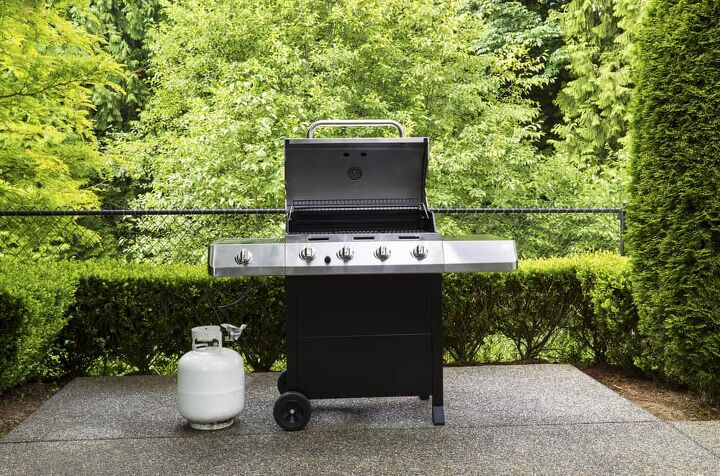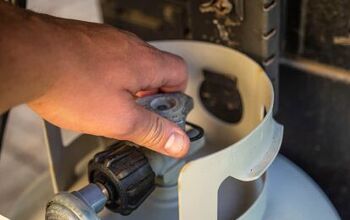How To Remove A Propane Tank From The Grill (Quickly & Easily!)

When we come to those beautiful days of Spring, we want to get back outdoors after a hard Winter. One of the first places we go to is the BBQ grill. That is where the good stuff is hidden.
Even before grilling comes up, we must keep in mind the maintenance of tearing down and setting up. There are steps to follow, and we can start by saving the grill. One of the critical steps before storage is removing the propane tank.
There are five easy steps to remove a propane tank from a grill from disconnecting to proper storage. The steps include ensuring everything is off when removing the pressure regulator and removing the hoses. The propane tank is connected to the grill by only one hose and pressure regulator nut.
Reasons to Remove a Propane Tank from a Grill
There are several reasons you may find yourself having to remove a propane tank from a grill. The number one reason is to refill it or exchange it. Some places can fill the tank, or you can go to a local grocery or convenience store and exchange the tanks.
Another reason you may find there is a problem with the hose or the tank. The hose may have a pinhole or maybe dry rotting and need to be replaced. Some tanks may have a bad connection and may be leaking or not fit properly.
Lastly, removing the tank from the grill happens when it is time for storage, and it is not in use. Mainly during the winter months, people do not want to BBQ in some locations. When the grill is out of commission for a while, it is best put away in storage for safekeeping.
When Do You Replace a Propane Tank?
Some propane tanks have a propane tank gauge to let people know how much propane is left. Other people have different methods of finding out how much propane is left in the tank. Either way, when the tank is empty, it is time to replace it or get it filled up.
Step 1. Run It Till Its Dry
Most people run their propane gas grills until the last drop. When this happens, the fire goes out, and the burners will not light back up. Everyone who cooks outdoors knows the best way is to always have a backup tank, just in case.
Step 2. When the Tank Expires, Exchange It
Many people do know a propane tank has an expiration date. It is usually ten to 12 years from the time of purchase. After this time is up, by law, the tank has to be replaced.
Sometimes you may continue to refill a tank. The person who sells the propane will look for the expiration date. If it is expired, they will not fill it and can discard it correctly for you.
The expiration date is found on the exterior of the cylinder. It is very dangerous to keep a tank past the expiration date. It is a ticking time bomb waiting to happen and can destroy homes, properties, and even lives.
Step 3. The Hot Water Trick
This trick comes from the science of propane. Propane is a freezing flammable gas. It can be a hot summer day; you will notice they will remain ice-cold to the touch.
Another trick of the trade to tell how much propane is taking hot water and pouring it over the tank. The empty part of the tank will be warm to the touch. The part where the propane is will still be iced cold.
It is an old-school way of doing things, but it works. It will not tell you how long before you run out, but it will give you an idea.
Step 4. Use the Bathroom Scale MethodDisconnect the tank from the grill and put it on the bathroom scale, standing upright. Take the weight of the scale, which is 18lbs, and subtract it from the weighted total. Each pound remaining in the difference will give you approximately one hour of cooking time.
Note: All times are approximate according to averages and the BTU output of the gas grill.
Why Store the Grill and Propane Bottle Separate
A grill is one of the most valuable items for the outdoors. Everything we cherish should be kept up with maintenance and proper storage. The best way to make it last is to take it apart, clean everything and separate it.
There is also safety as a number one priority behind dismantling the propane tank from the gas grill. Dismantling it keeps children and other people from messing with the tank. Doing so can cause severe injuries, even death.
Many people feel a grill is an outdoor luxury, and they leave everything outdoors. The best reason to store gas grills is to keep them looking new for as long as possible. The climates can dry rot the hoses, causing propane leaks.
Storing the tanks should be in a cabinet or someplace out of the reach of children. The grill should have a cover even though it is stored away in a shed or garage. Most people store away the hose under the grill’s hood keeping it out of the direct sunlight.
Good Things to Know About Propane Tanks
Some people wonder if they should refill or purchase another propane tank. There is no reason to spend more money on a new tank every time one goes empty. Filling a tank is the cheapest way among these three choices.
- Fill the tank with propane is between $1 to $2 per gallon.
- Purchase a new tank can cost $50 to $60.
- Exchange a tank can cost $25 to $30.
Another good thing to know in helping you determine when the tank will go empty is the time. A 20lbs cylinder tank will give you around 18 to 20 hours before the tank goes out on a gas grill. If you keep track of the time you fire up the pit, it will give you an estimate.
Precautions When Removing the Propane Tank From a Gas Grill
Here is a list of things to keep safety at the highest priority when disconnecting and storing a propane tank.
- Always disconnect a propane tank outdoors.
- Wear arm-length gloves to protect your hands and arms from metal edges and any propane that may seep out.
- Always close the valve before disconnecting the propane tank.
- Remove the regulators before removing the tank.
- Keep the POL fitting connector clean by placing it in a plastic bag.
- Mix water and soap to make sure there are no leaks before storing. If there is a leak, bubbles will foam up.
- When removing the tank from the grill, you will need a pair of pliers and a wrench.
The Importance of Knowing and Understanding the Connections and Propane Tank
Basic knowledge can save your life and those around you. Propane is a flammable gas that needs to be handled with caution. Get someone who knows how to remove the tank if you are not comfortable.
The propane tank has a valve at the top that turns in a clockwise direction for off and counterclockwise for on. The regulator hand wheel and the gas hose work in opposite directions for attachments and dismantling. Now that you know about the propane tank, you can follow these steps if you choose to do it yourself.
The Steps on How to Remove a Propane Tank from a Gas Grill
Everything is relatively easy once you know the parts and how to work them. Dismantling everything can take about 20 minutes.
Step 1: Turn Everything Off
Ensure the burners on the grill, the couplers, and the tank are completely turned off before disconnecting everything. Many times the coupler is forgotten. This will keep the propane from escaping into the air.
Step 2: Remove the Gas Line from the Grill and the Valves
In the back of the grill, there is a gas line to disconnect. Next, disconnect the gas valve.
Step 3: Remove the Regulator
Remove the LPG gas regulators from the tank. You will need the wrench to remove it.
Step 4: Remove the Gas Line
Unscrew the gas line from the propane tank and set everything aside.
Step 5: Remove the Tank and Store Everything
There is usually a harness that holds the tank in place. Remove the harness, then the tank, and store everything.
More Related Guides

We are a team of passionate homeowners, home improvement pros, and DIY enthusiasts who enjoy sharing home improvement, housekeeping, decorating, and more with other homeowners! Whether you're looking for a step-by-step guide on fixing an appliance or the cost of installing a fence, we've here to help.
More by Upgraded Home Team



























